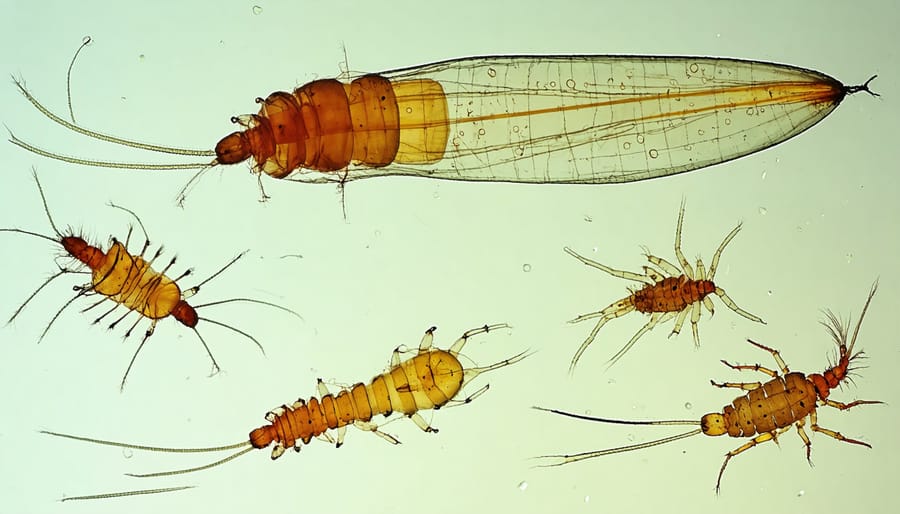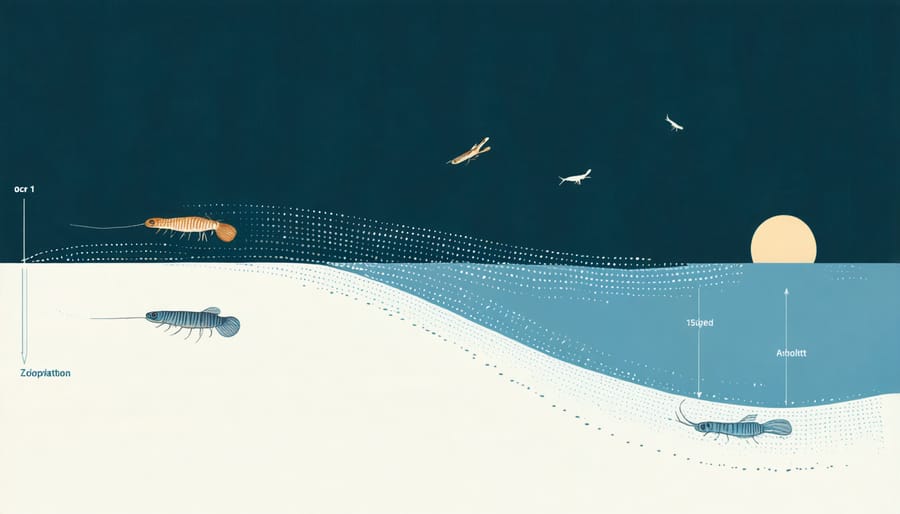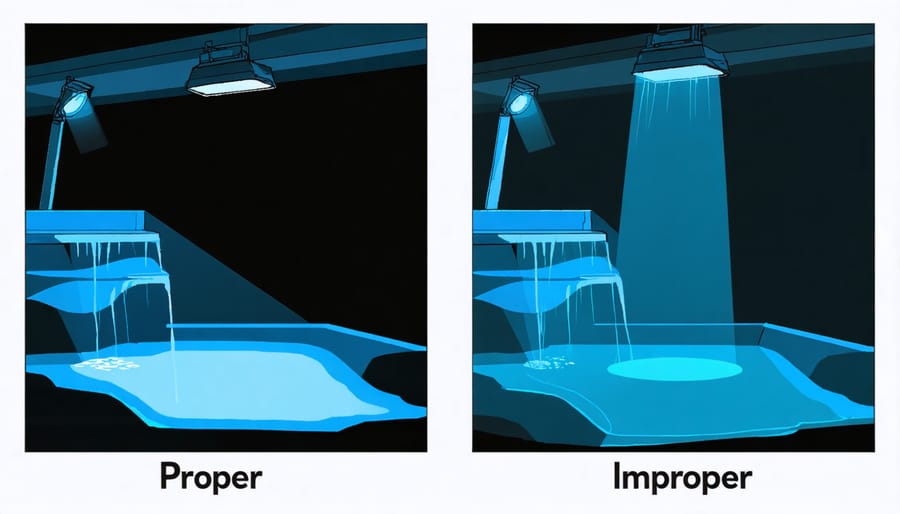
How Pond Lighting Affects Your Zooplankton (And Why It Matters)
Dive into the hidden world of zooplankton, nature’s tiny powerhouses that keep your pond crystal clear and teeming with life. These microscopic creatures, barely visible to the naked eye, form the crucial link between algae control and fish health in your backyard water feature. Like a microscopic cleanup crew, zooplankton constantly filter pond water, consuming excess algae and organic matter while providing essential nutrition for fish fry and other aquatic life. Whether you’re a seasoned pond keeper or just starting your water gardening journey, understanding these fascinating organisms is key to maintaining a thriving, balanced ecosystem. By learning to support your pond’s zooplankton population, you’ll unlock the secret to naturally clear water and reduce the need for chemical treatments, creating a self-sustaining aquatic paradise right in your backyard.
The Secret Life of Pond Zooplankton
Common Zooplankton in Garden Ponds
In most garden ponds, you’ll find a fascinating variety of tiny creatures swimming about. Daphnia, often called water fleas, are among the most common and beneficial zooplankton. These tiny crustaceans look like floating specks and help keep your pond water clear by feeding on algae.
Copepods are another frequent visitor, recognizable by their jerky swimming motion. They’re excellent natural cleaners, consuming both algae and organic debris. You might spot rotifers too – these wheel-like organisms are smaller than daphnia but just as helpful in maintaining pond health.
Fairy shrimp add a touch of magic to your pond, with their delicate, translucent bodies and graceful swimming patterns. Though less common than daphnia, they’re a delightful addition when they appear. During warmer months, you might notice cyclops, named for their single eye and distinctive swimming style.
These microscopic pond dwellers are more than just fascinating to watch – they’re essential players in your pond’s ecosystem, helping maintain water quality and providing food for fish and other aquatic life.

Why Your Pond Needs These Tiny Creatures
Think of zooplankton as nature’s tiny cleaning crew and fish food delivery service all rolled into one! These microscopic creatures are essential for creating a wildlife-friendly pond environment that thrives year-round. They feed on algae, helping to keep your pond water crystal clear naturally, without the need for harsh chemicals.
For your fish, zooplankton are like a constantly replenishing buffet of nutritious food. Baby fish, in particular, depend on these tiny organisms during their crucial early development stages. The presence of zooplankton also indicates your pond’s good health – they’re like little water quality indicators!
But that’s not all – these busy little creatures help cycle nutrients through your pond ecosystem, breaking down organic matter and making nutrients available for your aquatic plants. They even help control mosquito populations by feeding on their larvae, making your outdoor space more enjoyable for everyone.
By supporting zooplankton in your pond, you’re creating a self-sustaining ecosystem that requires less maintenance and provides better conditions for all your aquatic life.
Light and Zooplankton: A Delicate Balance
Natural Light Patterns
Zooplankton follow natural light patterns that guide their daily activities in your pond. Just like us, these tiny creatures have their own daily schedule, primarily driven by the sun’s movement across the sky. During daylight hours, many zooplankton species move deeper into the water to avoid predators and excessive sunlight. This behavior, known as vertical migration, is fascinating to observe in your pond.
As evening approaches and light levels decrease, zooplankton begin their upward journey toward the surface. This is when they’re most active, feeding on algae and other microscopic organisms. If you’ve ever noticed your pond seeming more “alive” at dusk, this is likely why! The darkness provides safety from fish and other predators that rely on sight to hunt.
The length of daylight also affects zooplankton breeding patterns. During spring and summer, when days are longer, zooplankton populations typically increase. In winter, with shorter days, their activity and reproduction naturally slow down. This seasonal rhythm helps maintain balance in your pond ecosystem.
For the best pond health, try to maintain these natural light patterns. Avoid using bright artificial lighting around your pond at night, as this can disrupt the zooplankton’s natural cycles. If you need lighting for aesthetics or safety, consider using dim, downward-facing lights that won’t interfere with their important nighttime activities.

Artificial Lighting Effects
Many pond owners love adding lights to their water features for aesthetic appeal, but these artificial lighting choices can significantly impact the tiny zoo swimming in your pond. Zooplankton, being naturally sensitive to light, can experience disrupted feeding and migration patterns when exposed to artificial illumination during nighttime hours.
If you’re planning to install pond lighting, consider using warm-toned LEDs and limiting their intensity. These gentle lighting options create a beautiful ambiance without severely disturbing your pond’s microscopic inhabitants. It’s best to position lights away from areas where zooplankton typically gather, such as deeper water sections or near aquatic plants.
While some UV lighting effects can help maintain water clarity, excessive artificial light can force zooplankton to seek darker areas, potentially affecting their natural behaviors and your pond’s overall ecosystem balance. To minimize impact, consider using timers to reduce lighting duration and create dark periods that allow these tiny creatures to follow their natural rhythms.
A good compromise is to use low-level lighting during evening hours when you’re most likely to enjoy your pond, then switching them off later at night. This approach allows you to appreciate your pond’s beauty while maintaining a healthy environment for your microscopic pond residents.
Optimizing Your Pond Lighting
Best Lighting Practices
Proper lighting plays a crucial role in maintaining a healthy zooplankton population in your pond. When implementing pond lighting techniques, it’s essential to strike the right balance between aesthetics and ecosystem health.
For optimal zooplankton activity, keep your pond lights at a moderate intensity. Too bright, and you’ll disrupt their natural behavior; too dim, and you won’t be able to enjoy your pond’s beauty. I’ve found that using 2-3 watts per square foot of surface area works perfectly for most garden ponds.
Position your lights at least 6-8 inches below the water surface, angling them slightly upward. This creates a beautiful effect while minimizing direct light exposure to zooplankton-rich areas. Remember to avoid placing lights directly in areas where zooplankton tend to gather, typically near aquatic plants and quieter corners of your pond.
Timing is everything! Set your pond lights on a timer to mimic natural daylight cycles. I recommend limiting artificial lighting to 4-6 hours in the evening, typically from dusk until about 10 PM. This gives your zooplankton plenty of dark hours to perform their natural activities while still allowing you to enjoy your pond during evening hours.
Consider using warm-toned lights (2700-3000K color temperature) rather than bright white or blue lights. These warmer tones are less disruptive to pond life and create a more natural, relaxing ambiance. For an added touch, try using adjustable LED lights that can be dimmed during critical zooplankton breeding periods.

Common Lighting Mistakes
Many pond owners unknowingly create lighting conditions that can harm their zooplankton populations. One common mistake is installing too many bright lights around the pond’s edge. These intense lights can disrupt the natural day-night cycle that zooplankton depend on for feeding and reproduction.
Another frequent error is using lights that shine directly into the water. This can cause zooplankton to migrate away from the surface, where they typically feed at night. Instead, they may hide in deeper areas, affecting the pond’s overall ecosystem balance.
Blue and white LED lights are particularly problematic. These wavelengths penetrate water deeply and can cause stress to zooplankton communities. Many pond enthusiasts don’t realize that warmer colors, like amber or soft yellow, are much gentler on these tiny creatures.
Leaving pond lights on all night is another mistake to avoid. This constant illumination interferes with zooplankton’s natural behavior patterns and can reduce their population over time. A better approach is to use timers to limit lighting to early evening hours when you’re most likely to enjoy your pond.
Remember that natural moonlight provides all the illumination your pond needs at night. If you must have lighting for safety or aesthetic reasons, keep it minimal and indirect. This approach will help maintain a healthy zooplankton population while still allowing you to enjoy your pond after dark.
In our journey through the fascinating world of pond zooplankton, we’ve discovered just how crucial these tiny creatures are to maintaining a healthy aquatic ecosystem. From their role in controlling algae growth to serving as a vital food source for fish, zooplankton truly are the unsung heroes of our ponds.
Remember that proper lighting management is key to supporting your pond’s zooplankton population. By maintaining natural day-night cycles and avoiding excessive artificial lighting, you’re helping these beneficial organisms thrive. Consider using timers for any decorative lighting and positioning lights away from the water’s surface when possible.
As you work on your pond, keep in mind that a healthy zooplankton population is often a sign of a well-balanced ecosystem. Regular monitoring of water clarity, avoiding overfeeding of fish, and maintaining appropriate plant coverage will all contribute to creating an environment where zooplankton can flourish.
By taking these simple steps to protect and nurture your pond’s zooplankton, you’re not just supporting these microscopic creatures – you’re investing in the overall health and beauty of your water garden. Whether you’re a seasoned pond keeper or just starting your aquatic journey, remember that every small effort in maintaining proper lighting conditions helps create a thriving pond ecosystem that you can enjoy for years to come.
